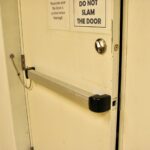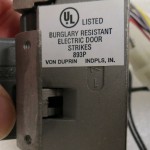Along with last week’s Fixed-it Friday photos, I asked some serious questions:
- Is it a code requirement that fire doors must only be used where the fire rating is required?
- Must the fire door label be removed if the fire rating is not required in that location?
- Does the door have to meet the requirements for a fire door assembly (closer, latch, etc.) just because has a label – even if a fire door is not required for that location?
NFPA 101 does not prohibit fire doors from being used where a fire door is not required, and if a fire door is installed where it is not required, NFPA 101 does not mandate that the assembly must meet all of the requirements of a fire door assembly. Labels are not required by NFPA 101 to be removed if the fire door is in a location where a fire door is not required. I requested and received a staff opinion from NFPA to confirm the intent of NFPA 101. The table in NFPA 101 which designates the ratings for opening protectives is called: “Table 8.3.4.2 Minimum Fire Ratings for Opening Protectives in Fire Resistance–Rated Assemblies and Fire-Rated Glazing Markings,” and the ratings established in that table are the MINIMUM requirements.
Several of the comments on Friday’s post mentioned the following section of NFPA 101, as a reason that labeled doors must be maintained as fire door assemblies (even if not required) or that the labels must be removed:
4.6.12.3* Existing life safety features obvious to the public, if not required by the Code, shall be either maintained or removed.
A.4.6.12.3 Examples of such features include automatic sprinklers, fire alarm systems, standpipes, and portable fire extinguishers. The presence of a life safety feature, such as sprinklers or fire alarm devices, creates a reasonable expectation by the public that these safety features are functional. When systems are inoperable or taken out of service but the devices remain, they present a false sense of safety. Also, before taking any life safety features out of service, extreme care needs to be exercised to ensure that the feature is not required, was not originally provided as an alternative or equivalent equivalent, or is no longer required due to other new requirements in the current Code. It is not intended that the entire system or protection feature be removed. Instead, components such as sprinklers, initiating devices, notification appliances, standpipe hose, and exit systems should be removed to reduce the likelihood of relying on inoperable systems or features. Conversely, equipment, such as fire or smoke dampers, that is not obvious to the public should be able to be taken out of service if no longer required by this Code. Where a door that is not required to be fire protection-rated is equipped with a fire protection listing label, it is not the intent of 4.6.12.3 to require such door to be self- or automatic-closing due merely to the presence of the label.
I understand the intent behind this section…if a building occupant sees a fire extinguisher, they would expect it to work – even if it’s not required in that location. But is the label on a fire door “obvious to the public”? If a building occupant sees a 90-minute label on a fire door, but the wall does not offer the same level of protection, does this put the building occupant at risk? Again – I requested a staff opinion from NFPA, and the staff member stated that a non-required fire door is not a feature that is obvious to the public in the context of paragraph 4.6.12.3. The last line from Annex A section A.4.6.12.3 (underlined above) was added in the 2015 edition of NFPA 101, and illustrates that the label is not required to be removed if the fire door is installed where it is not required, and that the door is not required to meet the requirements of a fire door assembly.
It’s possible that when an AHJ sees a labeled door, he or she may require the door to be compliant (as in my Fixed-it Friday post) unless the building owner can provide documentation showing that the door is not required to be fire rated. To avoid this, it may be easier to remove the label if it is not required.
As always, the AHJ has the final say, and for many health care facilities, the Joint Commission is the AHJ responsible for accrediting the facility. The Joint Commission’s current position is that a fire door assembly needs to match the level of protection provided by the wall, and that NFPA 101 section 4.6.12.3 does apply to fire door assemblies. Given the renovations to health care facilities that may have resulted in a reduction in required fire resistance, along with fire doors that were originally installed where not required, ensuring that fire door labels match the rating required by NFPA 101 is a major undertaking. I’m hoping to receive further clarification to resolve the difference between the NFPA 101 staff opinion and the Joint Commission position, and I will report back as soon as I do.
You need to login or register to bookmark/favorite this content.





Lori,
It should be noted that lots of products fire labels also carry additional requirements that the label covers. As an example, fire labeled exit devices must meet UL10C but must also meet UL305. Because of this, your panic listing is covered by the UL fire label. If you remove the fire label you also remove the proof of panic listing. Anyone that has tried to get replacement listing labels knows this is no easy task. Unless there is a very good reason to, you should never be removing fire labels from listed product.
You’re right Matt! I would never recommend removing the label from fire exit hardware.
– Lori
To make this more complicated, IBC 1008.1 states that “doors provided for egress in numbers greater than required by this code shall meet the requirements of this code”. In other words all of the fire rating elements of the door including the label shall be provided. So if you have additional doors used for egress, even though they are not required, they must comply with IBC Code as though they were required. I’m not trying to stray from the topic, but perhaps, the answers lie in the way the door is use.
Hi Dan –
I think that line is usually interpreted to mean that doors used for egress have to meet the egress requirements, not the fire door requirements, but interpretation is up to the AHJ so anything’s possible.
– Lori
This is a good series of questions, Lori.
I had a fire marshal tell me once that “you can’t un-label a fire door.” He said “you have to replace it with a standard door.” I thought then and still do that this was a ridiculous requirement. It would be nice to get a consensus answer on this.
Hi David –
I don’t know why the fire marshal would say that you can’t un-label a fire door…you definitely can if the label is not required. Some facilities do not want to remove unneeded labels because then the label is gone forever and they can’t reuse the door in a location that requires a fire rating.
– Lori
I conducted 17 Joint Commission inspectors in my career. I was often impressed by their knowledge and training. They could sometimes apply sensible codes in strange ways. In my early years, metal garbage cans were used. There was objections to using plastic liners in the cans because the several ounces of plastic was part of the fire load. The liners were really needed to keep transfer of trash from contaminating. I pointed out that the roughly 5 pound newspaper inside the liner of the can we were looking at was a far greater fire load than the liner and it was not logical to consider the small amount of plastic a significant hazard. I did not get any argument.
It would seem to me that if door hardware no longer needs to be fire rated and that it is no longer a component of a fire rated assembly as test by U.L. or others, it has become a really expensive ordinary door hardware. It should still perform the functions of the ordinary hardware such as latching, lack of double action locks, etc.
Happy Thanksgiving.
Happy Thanksgiving to you too, Jerry!
– Lori
I did not weigh in on the previous post, but put me down as somebody as likes to keep it simple.
If I am inspecting doors and I see a label on the door and frame I take it for face value and expect it to have all the qualities of it’s label. In my opinion it is not the fire door inspectors job to make sure that the rated assembly is actually in a rated wall.
There are exceptions to every rule, but rather than verify the rating of the wall assembly I’ll inspect and maintain the door as a fire door.
Hi David –
I can appreciate why that would be a better process for some facilities, but I think it should be up to the facility whether they want to deal with the extra documentation and keep the label, or maintain the door as a fire door, or remove the label. Needing to have the exact label required for the wall (not more) is another issue, and could be very difficult to coordinate for facilities with thousands of doors.
– Lori
Often the price difference between a labeled door and frame is not a huge deal (in hollow metal) or 1/3 hour fire doors. As a rule of thumb I advise our clients to have all their doors labeled, that way, in the event of an emergency, a labeled door is available on an expedited basis assuming the rating, swing, and hardware prep are the same.
Hi Mario –
That was mentioned in one of the emails that I received from a health care facility. If they are forced to remove the labels, they can never again use that door in a location that requires a label.
– Lori
Lori,
Here is my concern. NFPA 80 Standard for Fire Doors and Other Opening Protectives which is what “all” Fire Door assemblies are to be inspected by states in par 6.4.4.2 “Fire exit hardware shall be installed only on fire doors bearing a label stating “Fire Door to Be Equipped with Fire Exit Hardware.”” and par 6.4.4.2.3 “The label shall differentiated between panic hardware, which is not acceptable for use on fire doors, and fire exit hardware.” Should a Fire Door label be removed or remain in place is really not the safety issue as I see it. When an opening is no longer needed to provide fire safety it must still provide in most cases a means of egress. Should fire exit hardware be left on the opening (which most likely will occur because it will save cost), labelled or not and a fire occurs, the fuseable links in them that is designed to melt at certain temperatures will render the door useless for egress. We have now created a safety issue and God forbid that someone should die because they were unable to get out because the door was inoperable when it should have provided a means of escape for them.
I believe that there is no sufficient excuse that can be given to a loved one that their someone special died because the business found it more “cost effective” to not fully change out EVERYTHING when the opening needs changed. All business owners are responsible for providing a safe environment for their employees and the general public. When an attorney gets ahold of this information (which I’m sure a good one will), just how much more will the business owner have to spend to cover the lawsuits? Call me tender hearted, but I could not look a loved one in the eyes and tell them that I did everything I could to make sure their special someone was safe had this happened and I knew about it.
I believe it is ALWAYS better to error on the side of safety rather than bottom line.
Hi Paul –
During a fire test (and during a real fire with similar conditions), the operable hardware on the door – levers, touchpads, etc., will usually burn/melt off the door. The latch stays projected to ensure positive latching. By the time this happens in a real fire, the door is no longer being used for egress. If a fire door with fire exit hardware is installed where it is not required, or if the plans change and the fire door assembly is no longer required, I don’t think having fire exit hardware is less safe than having panic hardware. I agree that a door used for egress must be maintained code-compliant and available for egress, but I don’t think having a fire door vs. a non-rated door creates an egress problem.
– Lori
Please keep us informed on this I have the exact issue. My safety management team want all labels removed from all door that are not in fire walls. The most wasteful thing I have ever heard. Thanks Lori.
See https://submittals.nfpa.org/TerraViewWeb/ViewerPage.jsp?id=101-2018.ditamap&toc=false&draft=true
for the proposed revisions to NFPA 101 paragraph 4.6.12.3 and A.4.6.12.3. Obvious to the public has been changed to sprinklers, alarm sstems, standpipes and fire extinguishers, and the annex specifically addresses fire doors and frames. This is due to the concerns stated here..